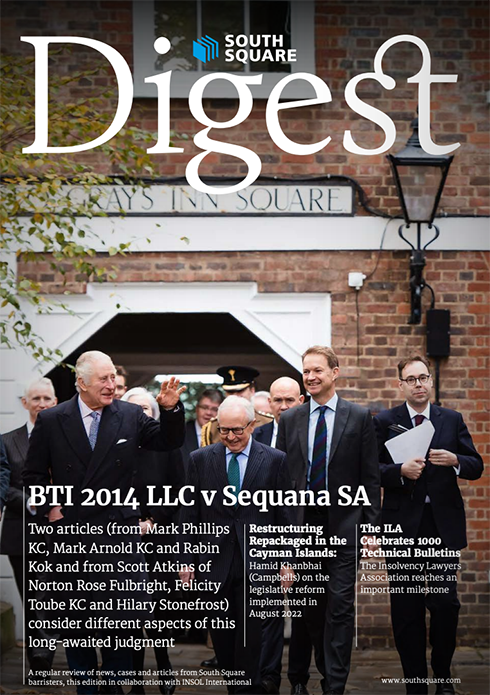

A. Introduction
On 5 October 2022 the Supreme Court (Lords Reed, Hodge, Briggs, Kitchin and Lady Arden) gave long-awaited judgment in BTI 2014 LLC v Sequana SA (“Sequana”). Sequana raised important questions in relation to the director’s duty to have regard to the interests of creditors when the company is in what is often called the “twilight zone”, but it was the wrong case on its facts to resolve many of the more nuanced questions that fall to be determined. What the Supreme Court confirmed is that the “rule in West Mercia”, so called after the Court of Appeal’s decision in 1987 in West Mercia Safetywear Ltd (in liq) v Dodd [1988] BCLC 250, is part of English law, but the Supreme Court’s decision says more about when the rule is not engaged rather than when it will be. It held that the payment of a dividend when the company was neither insolvent nor on the verge of insolvency did not mean the directors had to have regard to the interests of creditors, even if there might be a risk of insolvency at some point in the future.
B. The Facts
On 18 May 2009, Arjo Wiggins Appleton Ltd (“AWA”), a UK registered company, made a distribution of nearly all its net assets to its parent company, Sequana SA. AWA had a long-term contingent environmental liability in respect of clean-up costs as a result of the pollution of the Fox River in Wisconsin2. AWA followed the statutory procedure in Part 23 of the 2006 Act for quantifying the amount that may be paid by way of distribution, including the preparation of relevant accounts, and made proper provision for its contingent liability. Some years after the distribution was made, it emerged that the contingent environmental liability, was much greater than originally estimated, and A Ltd became insolvent3. By then, however, AWA had already commenced proceedings against its directors for breach of duty, which it subsequently assigned to BTI 2014 LLC. The critical fact was that the distribution had been made some years before, at a time when Sequana was neither actually insolvent, nor imminently insolvent, nor in a position where insolvency was probable. The most that could be said at the time was that the estimate might turn out to be too little such that there was a real risk of insolvency.
Rose J at trial found that the distribution was lawfully made and that the risk of AWA’s insolvency at the time of the distribution was not sufficient to trigger an obligation to consider creditors’ interests. At the time of the distribution, AWA was not insolvent or likely to become insolvent. In her view, the Fox River liability was a long-term liability for which the directors had made their best estimate, and to hold them responsible for creditors’ interests whenever there was a risk that the estimate would turn out to be wrong would be a significant, unprincipled, inroad into the normal way in which directors’ duties applied.4
The Court of Appeal dismissed the appeal5. Judgment was delivered by David Richards LJ who held that the Court of Appeal was bound by the decision in West Mercia to hold that the directors owed a duty to consider the interests of creditors and that the authorities showed that the duty in relation to creditors was triggered when the directors knew or should have known that the company was insolvent6. In his judgment, the duty arose immediately prior to insolvency. Eschewing words suggesting that the test is that insolvency is imminent as they suggested a temporal test, however, he concluded that the duty arises when the directors know or should know that the company is likely to become insolvent, meaning that it will probably do so7. The company was not insolvent when the distribution was paid, and nor could it be said that it would probably become so. The duty did not arise simply because there was a real, and not remote, risk of insolvency.
An important question that the Court of Appeal left open – because it did not arise on the facts – was how much weight should be given to creditors’ interests – were their interests paramount, or simply one factor among many for directors to weigh when faced with difficult business decisions? That said, David Richards LJ found it difficult to see how creditors’ interests could be anything but paramount when a company was actually and presently insolvent, and said so.8
C. West Mercia - The Beginnings
Before Sequana, the existence of the ‘creditor duty’ in West Mercia was recognised (albeit obiter) in no fewer than five judgments at the highest level –including the Supreme Court’s decision in Bilta (UK) Ltd v Nazir (No. 2)9 and the Privy Council’s decision in Ciban Management Corp v Citco (BVI) Ltd10.
It is perhaps surprising that the parties thought the existence of the rule was ‘up for grabs’, given how well established the West Mercia rule has become in common law jurisdictions and how readily the Justices have endorsed its existence, albeit in obiter dicta and while sitting as members of the JCPC. Nevertheless, the existence of the West Mercia rule was directly in issue in Sequana, and the court took the opportunity to conduct a root-and-branch examination of the origins of the rule.
West Mercia Safetywear Ltd was a subsidiary of AJ Dodd & Co Ltd. Mr Dodd, the director of both companies, transferred £4,000 from West Mercia’s account to its parent’s account, shortly before both went into liquidation. The parent having no assets available to enable it to repay, the liquidator of West Mercia sought an order that Mr Dodd repay the £4,000 instead. However, the first instance judge held that Mr Dodd had breached no duty to West Mercia because he was discharging a debt for West Mercia’s benefit and, by extension, its shareholders.
The judge had found as a fact that both companies were not just distressed but insolvent when the £4,000 was paid11. So the question of whether there was a duty in the ‘twilight zone’ did not arise. The only question was whether Mr Dodd had breached any duty. The authorities on the topic were, it seems, in some disarray. The difficulty faced by counsel for the liquidators was that, in the Multinational Gas case, Dillon LJ had appeared to close off the path to the development of a creditor duty in English law, stridently declaring that:
“The directors indeed stand in a fiduciary relationship to the company, as they are appointed to manage the affairs of the company and they owe fiduciary duties to the company though not to the creditors, present or future, or to individual shareholders.”12
In West Mercia, Dillon LJ was quick to point out that his words had been directed at solvent companies where the shareholders retained the economic interest. Insolvent corporations were a different matter. Here, Dillon LJ agreed with what Street CJ had said in Kinsela v Russell Kinsela Pty Ltd, an Australian authority that he had been referred to in argument:
“In a solvent company the proprietary interests of the shareholders entitle them as a general body to be regarded as the company when questions of the duty of directors arise… But where a company is insolvent the interests of the creditors intrude. They become prospectively entitled, through the mechanism of liquidation, to displace the power of the shareholders and directors to deal with the company’s assets. It is in a practical sense their assets and not the shareholders’ assets…”13
That being so, the Court of Appeal had no difficulty in concluding that Mr Dodd caused the £4000 to be transferred in disregard of the interests of West Mercia’s general creditors and was liable accordingly for misfeasance.
In Sequana, the court probed the historical origins of West Mercia more searchingly. Viewed against the long history of the common law Kinsela was an innovation, but Street CJ’s pronouncement was far from being without any basis in authority. As Lord Reed recounts:
“29. A number of significant developments have occurred in relatively recent times. An early pointer was an influential dictum in the Australian case of Walker v Wimborne (1976) 137 CLR 1, where Mason J observed at p 7 that “the directors of a company in discharging their duty to the company must take account of the interest of its shareholders and its creditors”, explaining that “[a]ny failure by the directors to take into account the interests of creditors will have adverse consequences for the company as well as for them.”…
30. The idea that creditors’ interests might be a relevant factor received more extended consideration in the New Zealand case of Nicholson v Permakraft (NZ) Ltd [1985] 1 NZLR 242 (“Permakraft”), where Cooke J expressed the view, obiter, that directors might owe a duty to the company to consider the interests of creditors “if the company is insolvent, or near-insolvent, or of doubtful solvency, or if a contemplated payment or other course of action would jeopardise its solvency” (p 249). He considered that such a duty might apply in respect of the interests of “current and likely continuing trade creditors” (ibid), but not other creditors. He stated that such a duty could be justified on the basis that “[i]n a situation of marginal commercial solvency such creditors may fairly be seen as beneficially interested in the company or contingently so” (p 249)…
31. That reasoning influenced the judgment of Street CJ in Kinsela v Russell Kinsela Pty Ltd (1986) 4 NSWLR 722 (“Kinsela”), a decision of the New South Wales Court of Appeal which heralded a more radical change in the way in which the law understands the concept of a company’s interests…”
Lord Briggs went even further back, tracing the “radical” idea in Kinsela to the ancient recognition that debtors have duties to their creditors:
”[T]he company itself owes responsibilities to its creditors once it is insolvent, so that the directors as the custodians of the conscience of the company are duty bound to the company to see that it performs those obligations. The notion that insolvent persons have responsibilities to their creditors goes back to Roman law, in the Lex Paulina. This basic principle has long since been given effect to by statutory provision, both in England and Scotland …”14
Lady Arden, it should be noted, agreed that the seed of the idea recognised in Kinsela and thence in West Mercia was rooted in authority, though her survey was somewhat briefer.15
D. The West Mercia Duty in the Supreme Court
The Supreme Court acknowledged that the Sequana appeal raised questions of considerable importance for company law, but also noted that it was necessary to express provisional views about some issues which did not call for a final decision. It is important to note that the differences in reasoning, certainly among the four majority Justices, arose on matters which did not arise for decision. Still, this divergence will be a source of some uncertainty for directors and insolvency lawyers for some while to come.
The Supreme Court rightly held that there is no separate “creditor duty” i.e. a duty owed directly to creditors. That was not what West Mercia had held – the director’s duty was a duty owed to the company as part of the director’s fiduciary duties, specifically the duty to act in good faith in the interests of the company (now codified as the duty to promote the success of the company).16 What changes is the content of that duty. When the company is insolvent or in the twilight zone that duty includes having regard to the interests of the creditors. As Lord Reed put it “there are circumstances in which, for the purposes of the [director’s duty to act in the interests of the company], the duty should be understood as including the interests of its creditors as a whole.”17
The ratio of Lord Reed’s judgment is contained in the following passage:
“Where the modifying rule applies – a rule which I shall describe as the rule in West Mercia, after the leading case … the company’s interests are taken to include the interests of its creditors as a whole. The duty remains the director’s duty to act in good faith in the interests of the company. The effect of the rule is to require the directors to consider the interests of creditors along with those of members. The weight to be given to their interests, insofar as they may conflict with those of the members, will increase as the company’s financial problems become increasingly serious. Where insolvent liquidation or administration is inevitable, the interests of the members cease to bear any weight, and the rule consequently requires the company’s interests to be treated as equivalent to the interests of its creditors as a whole.”18
In answering whether there is a “rule in West Mercia”, Lord Briggs held:
“I am persuaded that the undertaking of that re-appraisal shows that the existence of a creditor duty at common law is sufficiently established, and sufficiently well-founded on principle, for it to be appropriate for this court to affirm it.”19
Lord Kitchin agreed with Lord Briggs’ majority judgment, as did Lord Hodge.
As for when the rule applies, Lord Reed said:
“I am satisfied that the rule in West Mercia does not apply merely because the company is at a real and not remote risk of insolvency at some point in the future. I therefore agree with the other members of the court that the appeal falls to be dismissed, and the claim fails.”20
The rationale of the rule
Lord Reed explained the rationale of the rule in West Mercia as follows:
“It can be explained … on the basis that, where the rule in West Mercia applies, the company’s creditors have an economic interest in the company, based upon their entitlement to be paid the debts owed to them, ultimately enforceable against the proceeds of realisation of the company’s assets, which is distinct from the interests of its members and requires separate consideration: something which can be taken to occur when the c liquidation or administration is probable, or where the transaction in question would place the company in one of those situations.21
“…where a company is insolvent or bordering on insolvency, the way in which the interests of the company are understood, for the purposes of the directors’ duty to act in good faith in its interests, is extended so as to include the interests of the company’s creditors as a whole as well as those of its shareholders. Where the company’s interests have to be understood in that extended sense, it will be a breach of the directors’ duty to the company for them to act in disregard of the creditors’ interests.22
Lord Briggs explained the rationale in similar terms:
“…it is not an abuse of language to describe creditors as having the main economic stake in the liquidation process which may be triggered by insolvency, and therefore as persons whose interests must be taken into account (albeit not necessarily as paramount) by the company’s fiduciary managers, while still in control of the management of the insolvent company before the onset of liquidation.23
Lord Hodge said at the outset: “I am satisfied that the directors of a company which is insolvent or is bordering on insolvency owe a duty to the company to have proper regard to the interests of its creditors and prospective creditors.24 He put the rationale in the following two passages:
“When a company is insolvent or bordering on insolvency its creditors are recognised as having a form of stakeholding in the company, and its directors from that point must have a proper regard to the interests of the company’s creditors as a body… I am satisfied that that remains good law. While the law in this area has remained in a relatively undeveloped and ill-defined state, I was not aware, until this appeal, of any serious challenge by company law practitioners to the existence of this fiduciary duty, which has been upheld by experienced commercial judges in a number of first instance decisions.25
“A company’s creditors always have an economic interest in its continued solvency so that it can pay its debts to them. The relative importance of that economic interest or stakeholding as against the economic interest or stakeholding of the company’s shareholders increases when a company is bordering on insolvency. It is this shift in relative economic interest or, in Lord Briggs’ non- technical words, “skin in the game”, that gives rise to the fiduciary duty to the company to give separate and proper consideration to the interests of a company’s creditors.26
Lady Arden’s judgment is difficult in places, not least because on some issues her reasoning was in the minority.
Lady Arden’s description of the underlying rationale of the rule in West Mercia was, at times, consonant with Lord Reed’s analysis. She said:
“As Lord Reed explains… the rule in West Mercia applies when the economic position of the creditors changes: that analysis is an endorsement of the emphasis in the case law on the practical operation of the law in this field … the rationale of the Rule in West Mercia is the need to ensure, so far as practicable, that creditors are not harmed by the asymmetry in governance following on from the shift in the economic interest which Lord Reed describes.27
“It is only right that the fiduciary duties of directors should be qualified to provide appropriate protection to creditors and approving the Rule in West Mercia has the advantage of endorsing the high standards expected of directors.28
However, Lady Arden’s primary focus was on showing that the duty was a negative duty, taking the form of one not to cause harm to creditors. In her view, the rule was ultimately concerned to solve the ‘principal-agent problem’ that arises because creditors are not in the ‘driver’s seat’ of a company prior to its insolvency and cannot control what the directors do:
“The correct analysis is that they may not exercise any of their powers so as to harm creditors’ interests. … [T]he purpose of the Rule in West Mercia is to redress the situation that creditors do not have any control over the management of the company at a time which is critical for the recovery of what is due to them. Given this purpose, the requirement of the Rule in West Mercia in practical terms is in my judgment a requirement on directors to consider creditors’ interests at all material times and not to harm their interests.29
E. Sequana: Questions Answered
Turning to the questions considered and the answers provided:
The answer to question (1) – Does the rule in West Mercia even exist? Yes
Lord Reed held:
“This is the most fundamental question raised by this appeal. I answer it in the affirmative. It is clear that such a rule was recognised by the Court of Appeal and lower courts before the enactment of the 2006 Act. The existing law in this regard was preserved by section 172(3) of that Act, as this court has previously accepted in the cases of Bilta (UK) Ltd v Nazir (No 2) and MacDonald v Carnbroe Estates Ltd. I am satisfied that the rule has a sound legal basis….30
Having debated the issues, Lord Briggs stated the answer to question 1 succinctly: “I would resolve the first issue against the respondents”.31
The answer to question (2) – the content of the duty: It depends
Lord Reed held the rule modifies the director’s duty:
“…the effect of the rule in West Mercia is to preserve the directors’ duty to act in the interests of the company, but to modify the sense of the latter expression so that, where the rule applies, the interests of the company are no longer regarded as solely those of its shareholders but are understood as including those of its creditors as a whole.32
Lord Reed, agreeing with Lord Briggs,33 approved the nuanced description of the duty by Lt. Bailiff Hazel Marshall QC in Carlyle Capital Corp v Conway,34 a judgment of the Royal Court of Guernsey:
“I formulate the principle …to take account of differences, according to particular circumstances, in what it may be reasonable and responsible for directors to do when they find that the company is in a sufficiently weak financial situation that a conflict of interest between its creditors and its shareholders appears to arise. The company is not – yet – in insolvent liquidation and remains under the management of the directors. Their duty is to decide what is in the extended best interests of the company in the particular case. It may well be that in some, possibly even most, situations, the company should thenceforth be run with regard to the best interests of its creditors alone, but that will not necessarily be true in all cases, and it is for that reason that I reject the word ‘paramount’.”
Lord Briggs emphasised that it is a fact sensitive question:
“…prior to the time when liquidation becomes inevitable and section 214 becomes engaged, the creditor duty is a duty to consider creditors’ interests, to give them appropriate weight, and to balance them against shareholders’ interests where they may conflict.35
Lady Arden said that the rule in West Mercia is in two parts:
“The first part is the requirement for directors to consider creditors’ interests. This arises whenever a company is financially distressed. By that I mean, …. the company is insolvent or bordering on insolvency, or an insolvent liquidation or administration is probable, or the directors plan to enter into a transaction in question would place the company in one of those situations.36
Again, and unlike the other members of the Court, Lady Arden conceived of the rule as a ‘harm prevention rule’. Her analysis, therefore, requires directors to think each action by the company through carefully, to consider if it would make creditors better off than in a liquidation:37
“If they consider in good faith, and having performed their duty of skill and care, that they can and should take action to promote the continued viability of the company, and that there is a way out of the company’s financial difficulties, which will benefit shareholders and creditors, they are not obliged to treat the creditors’ interests as the exclusive or primary determining factor in what they do next. However, since directors are obliged not materially to harm creditors’ interests, they must be satisfied that the general body of creditors would be better off under that measure than if the company is immediately put into liquidation or equivalent process…”
Question (3) – when does the creditor duty apply? When insolvency is actual or imminent
The Supreme Court unanimously rejected the argument that the test should apply when there is a real rather than remote risk of insolvency or when insolvency is likely or even probable.
Lord Reed said that he was inclined to agree that it is sufficient if the company is “insolvent or bordering on insolvency” – in other words once the company has entered the so-called ‘twilight zone’ and insolvency is imminent:
“… the critical factor is whether, given where the economic interests lie, and the consequent distribution of risk, it continues to be appropriate to treat the interests of the company as equivalent to the interests of its shareholders alone.38
Lord Briggs described the principle as follows:
“The true principle … is that creditors (or at least unsecured creditors) are not the main stakeholders in the company at any earlier date than when it goes into insolvent liquidation, at which point they acquire statutory priority in an entitlement to share pari passu in any distributions which that process may generate. It is that prospective entitlement which entitles them to have their interests considered, although not necessarily given paramountcy, when the onset of insolvency makes that prospect both much more likely and one which may be beyond the ability of the company to control, in the sense that insolvency immediately exposes a company to being wound up at the behest of any unpaid creditor.39
Lord Briggs then formulated when the duty applies:
“I would prefer a formulation in which either imminent insolvency (ie an insolvency which directors know or ought to know is just round the corner and going to happen) or the probability of an insolvent liquidation (or administration) about which the directors know or ought to know, are sufficient triggers for the engagement of the creditor duty. It will not be in every or even most cases when directors know or ought to know of a probability of an insolvent liquidation, earlier than when the company is already insolvent. But that additional probability-based trigger may be needed in cases where the probabilities about what lies at the end of the tunnel are there for directors to see even before the tunnel of insolvency is entered.40
Lords Kitchin and Hodge agreed with this formulation.41 Lord Reed was “inclined to agree” with Lords Briggs, Kitchin and Hodge that the probability of an insolvent liquidation or administration would also suffice, but was “less certain” that it is essential that the directors “know or ought to know” that the company is bordering on insolvency. Lady Arden said she would leave the question of knowledge open for full submissions. It may be that the ‘twilight zone’ is a state of affairs and should not turn on the director’s state of mind.
Lady Arden said that “the interests of creditors can only supplant the interests of shareholders altogether when the company becomes irreversibly insolvent, making insolvent liquidation or an administration unavoidable.42 She agreed that “the test of a real and not remote risk of insolvency and the test of likelihood of becoming insolvent should be rejected.43
Interaction with other provisions of the Insolvency Act 1986
The Supreme Court was asked to consider the interaction of the rule in West Mercia with provisions of the Insolvency Act 1986, but, as the conclusion was that the provisions all work in different ways and none is incompatible with the rule in West Mercia, there is no need to elaborate here.
Interaction with the “ratification principle”
The Supreme Court recognised the interplay between the rule in West Mercia and what Lord Briggs referred to as the ratification principle (shorthand for the ability of shareholders, formally or informally, to authorise or ratify conduct that would otherwise constitute breach of duty on the part of the directors). Sensibly, the two cannot operate simultaneously, and it is accepted that the latter cannot operate when the company is actually insolvent, as Dillon LJ recognised in West Mercia itself. What falls to be determined more precisely another day is when – short of actual insolvency – that moment comes when the shareholders are deprived of that power, and whether on the facts of the case they have been. It sufficed for the purposes of decision in Sequana that the rule and the principle are not incompatible or irreconcilable such as to throw doubt on the existence of the rule itself; rather, the authorities show that the principle can “readily adapt to the creditor duty on a principled basis.44
The Debate Surrounding the work of the Company Law Review Steering Group (“CLRSG”)
There was a surprisingly lengthy debate about the effect of section 172(3) of the Companies Act 2006 and the views of CLRSG, which had recommended a statutory statement of the main fiduciary duties of directors and their duty of care and skill.
Lord Briggs said Parliament must be taken to have understood that West Mercia was binding law and section 172(3) had affirmed its existence:
“…the existence (although not the precise content and engagement) of the creditor duty was affirmed as existing at common law in section 172(3). That subsection needs to be interpreted in its historical context. It refers to “any enactment or rule of law” and makes the general duty set out in the rest of section 172 subject to it….Parliament must be taken to have understood the general state of the common law at that time, which by the binding Court of Appeal authority of the West Mercia case did clearly recognise a creditor duty, even if the precise content of that rule of law may have had fuzzy edges, and might thereafter be subject to further judicial development.45
Disagreeing with Lady Arden’s analysis on this point, Lord Briggs agreed with Lord Reed that section 172(3) speaks for itself in sufficiently clear terms. He also agreed, however, with Lord Hodge’s analysis of the legislative history.46
Lord Hodge, who, along with Lady Arden, was a member of the CLRSG said:
“In my view, in agreement with Lord Briggs, the words of section 172(3) of the 2006 Act point towards the purpose of preserving the common law as it had been developed before the 2006 Act, particularly in [West Mercia]. That interpretation of the subsection is supported by a consideration of its historical origins…”47
Lord Hodge noted that “it was recognised that directors were subject to other duties which were not included in the proposed codification.48 Like Lady Arden, Lord Hodge analysed the debate at the time but reached a different conclusion. Lord Hodge referred to the White Paper (which is admissible) which said:
“In doing so, it preserves the current legal position that, when the company is insolvent or is nearing insolvency, the interests of the members should be supplemented, or even replaced, by those of the creditors.49
That was a recognition of the existence of the rule in West Mercia. It was also recognised in the explanatory notes:
“314. It has been suggested that the duty to promote the success of the company may also be modified by an obligation to have regard to the interests of creditors as the company nears insolvency. Subsection (3) will leave the law to develop in this area.50
Lord Hodge’s conclusion (with which Lords Briggs and Kitchin agreed) was:
“…the relevant background shows that the Government in introducing the Bill considered that it was preserving the then current legal position and, more significantly, that Parliament itself explained both that section 172(3) was a recognition that the section 172(1) duty is displaced on insolvency (para 313) and that the subsection allowed the common law to be developed by modifying the section 172(1) duty when a company nears insolvency…”51
Lady Arden’s analysis of the history of the duty, and of the effect of section 172, is a minority view. Lords Reed, Briggs, Kitchin and Hodge all disagree with her. Lady Arden’s commentary tilts at the proposition that there is a direct duty to creditors, but that was not how it had been articulated in West Mercia or in any of the subsequent cases. Lady Arden is also in a minority in saying that:
“What is said is that West Mercia brought into UK law principles about the duties of directors of insolvent companies which had been developed in the Antipodes, and so I will begin by considering the law from that source before I consider West Mercia. In my judgment, West Mercia only approves a limited part of the Antipodean approach.”
It is respectfully suggested that this is to construe Dillon LJ’s words in West Mercia as if it was a statute; whereas what Dillon LJ was really doing was applying the rationale of the antipodean authorities.
Lady Arden also highlighted that the other members of the Permakraft court had been reluctant to recognise a ‘creditor duty’ of any kind:
“If this Court is to move in that direction its decision to do so would need to be based on a thorough examination of the scheme and purpose of the companies’ legislation. I prefer to leave that for a case where this question, itself a difficult amalgam of principle, policy, precedent and pragmatism, must be decided.52
She then pointed out that Street CJ had hesitated:
“to attempt to formulate a general test of the degree of financial instability which would impose upon directors an obligation to consider the interests of creditors”, citing the courts’ traditional and proper caution about pronouncing on the commercial justification for a directors’ decision (p 733).
Lady Arden’s analysis appears to have put more weight on the views held by members of the CLRSG (including those of the late and great Richard Sykes QC) than the language of section 172(3) itself and the decided cases. The thrust of Lady Arden’s judgment is that West Mercia did not add to the pre-existing law on directors’ fiduciary duties:
“Rightly or wrongly the view held at the time was that there was doubt as to the existence of the Rule in West Mercia.53
This is somewhat surprising given how radical the idea recognised in Kinsela and later in West Mercia was and, as Lord Hodge and Lord Briggs point out, that wasn’t the view of Parliament. As the other Justices seem to have recognised in their survey, section 172(3) recognised the rule in West Mercia, which has now come of age.
F. Concluding Thoughts
Lord Reed recognised the practical need for clarity in this area of the law.54 What, then, did the Supreme Court decide?
The Justices unanimously decided that a real rather than a remote risk of insolvency was not enough to trigger the rule in West Mercia, but the rule definitely exists and could apply in relation to a dividend otherwise lawfully made, just as Rose J and the Court of Appeal had previously decided.
Where the Supreme Court differed from the Court of Appeal was in rejecting the probability of insolvency as the trigger altogether, reverting instead (by a majority of four) to language requiring insolvency to be imminent, with the probability of insolvent liquidation or administration as an alternative, and (by a majority of three) that the directors know or ought to know that the company is in this position.
Such “imminent” language had previously been considered vague, and so it is. In circumstances where the enquiry must inevitably be fact specific, however, the Supreme Court must be taken to be satisfied that such language adequately conveys the general requirement – at least for the moment. Strictly speaking, the point may be open for further argument in a case on the facts of which the question actually falls to be determined. In the meantime, directors must look to see whether there is “light at the end of the tunnel” and, if so, how bright it is, or whether insolvency is “just around the corner”, taking some comfort, perhaps, from the Supreme Court’s clear view that merely transitory insolvency doesn’t count.
Having recognised the interplay between the rule in West Mercia and the ratification principle, and that the two cannot operate simultaneously, they can and must continue to adapt to each other on a principled basis. That’s for another day.
Finally, how are directors to act when the rule in West Mercia is triggered? The guidance from the Supreme Court is that the weight to be attached to creditors’ interests will depend on the circumstances of the case. But Sequana neither called for any deeper analysis of what might be expected of directors and, unsurprisingly, nor do the judgments provide one. That too must wait for another day.
1 Mark Phillips was Counsel for the Liquidator in West Mercia Safetywear v Dodd
2Sequana at [115]; BAT Industries plc v Sequana SA [2017] Bus. L.R. 82 (Sequana (HC)) at [5]
3 Sequana (HC) at [6]
4Sequana (HC) at [479]
5BAT Industries plc v Sequana SA [2019] 2 All E.R. 784 (“Sequana (CA)”)
6Sequana (CA) at [217], and the preceding paragraphs.
7Sequana (CA) at [218]-[221]
8Sequana (CA) at [222]
9[2016] AC 1, at [38] (Lord Mance)
10[2021] AC 122 at [40] (Lord Burrows). See also Stone & Rolls Ltd v Moore Stephens [2009] AC 1391, Lord Mance at para 236; MacDonald v Carnbroe Estates Ltd [2019] UKSC 57, Lord Hodge at para 33; and Byers v Chen [2021] UKPC 4, Lord Kitchin at para 91.
11West Mercia Safetywear v Dodd, 251g
12[1983] Ch 258, 288
13(1986) 4 NSWLR 722, 730
14Sequana (SC) at [129] and [146]
15BTI 2014 LLC v Sequana SA [2022] UKSC 25 (“Sequana (SC)”) [252]-[260]
16Sequana (SC) at [112], [135], [261]-[277]
17Sequana (SC) at [11]
18Sequana (SC) at [11]
19Sequana (SC) at [138]
20Sequana (SC) at [14]
21Sequana (SC) at [12]
22Sequana (SC) at [51]
23Sequana (SC) at [147]
24Sequana (SC) at [207]
25Sequana (SC) at [207]
26Sequana (SC) at [246]
27Sequana (SC) at [256]
28Sequana (SC) at [258]
29Sequana (SC) at [288]
30Sequana (SC) at [76]
31Sequana (SC) at [157]. The SC was unanimous on this point: see also Lord Hodge at [207] and [228], and Lady Arden at [250]
32Sequana (SC) at [79]
33Sequana (SC) at [82] and [171] respectively.
34Judgment 38/2017 (unreported), 4 September 2017, set out in Sequana (SC) at [170].
35Sequana (SC) at [176]
36Sequana (SC) at [279]
37Sequana (SC) at [284]
38Sequana (SC) at [87]-[88]: he considered that other phrases adopted in the authorities were “broadly synonymous”, all conveying “a sense of imminence”.
39Sequana (SC) at [192]
40Sequana (SC) at [203]
41Sequana (SC) at [227]
42Sequana (SC) at [306]
43Sequana (SC) at [306]
44Sequana (SC), Lord Briggs at [149]
45Sequana (SC) at [153]
46Sequana (SC) at [154] and [204]
47Sequana (SC) at [209]
48Sequana (SC) at [210]
49Sequana (SC) at [220]
50Quoted by Lord Hodge in Sequana (SC) at [314]
51Sequana (SC) at [222]
52Per Richardson J and Somers J in Permakraft at 255, cited in Sequana (SC) at [393]
53Sequana (SC) at [440].








![Brake & Anor v The Chedington Court Estate Ltd [2023] UKSC 29](https://southsquare.com/wp-content/uploads/2024/02/Brake-Anor-1-scaled.jpeg)










